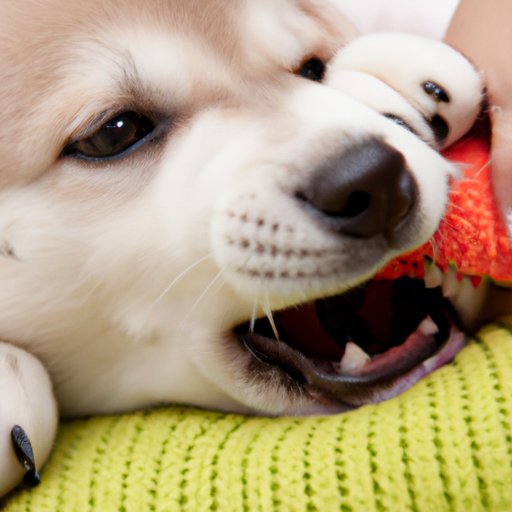I. Introduction
As a new puppy owner, one of the most challenging issues you’ll have to face is managing your furry friend’s habit of biting. Puppies have a natural inclination to chew and nip just about everything in sight, including hands, fingers, ankles, and shoes. While this behavior is perfectly normal, it can be aggravating and even painful. Fortunately, there are several easy and effective ways to manage puppy biting and help your puppy grow into a well-behaved adult dog.
II. Start with socialization training
Socialization training is a process of familiarizing your puppy with different people, animals, and environments. This type of training is essential for puppies to learn appropriate behavior and develop healthy social skills. Socialization also plays an important role in reducing the likelihood of puppy biting.
When puppies are socialized, they learn to recognize the boundaries of appropriate behavior, especially with other dogs or humans. They become more comfortable and less fearful around strangers, thus reducing the anxiety and nervousness that often trigger biting behavior.
To socialize your puppy, you should take them for walks, introduce them to other dogs, and let them interact with other people besides you. Ideally, this should start at an early age. The more your puppy is exposed to different situations, the more comfortable they will become in new situations, reducing the likelihood of biting.
III. Divert their attention with toys
A great way to stop a puppy from biting is to divert their attention with toys. When puppies are bored, they instinctively need an outlet to relieve their energy, and this often leads to them biting and chewing whatever is in front of them. Toys can act as a healthy outlet for their chewing and biting behavior. They also teach puppies what is appropriate to chew on and what is not.
When choosing toys for your puppy, opt for those that are durable, easy to clean, and safe. Be mindful of any small parts that may pose a choking hazard, and avoid anything that’s too hard and heavy for your puppy’s little teeth. It’s also a good idea to provide a variety of toys to keep your puppy stimulated and interested in their environment.
If your puppy starts biting you or someone else, redirect their attention to their toys. A simple “No” followed by giving them a toy can teach them that biting hands or feet is not appropriate.
IV. Use positive reinforcement
Positive reinforcement is a training approach that rewards good behavior. This technique has been proven effective in teaching new behavior or modifying existing behavior, including stopping puppy biting. Positive reinforcement teaches the puppy what is good behavior by reinforcing that behavior with rewards, such as treats and praise.
When using positive reinforcement to stop puppy biting, it’s essential to reward them when they show good behavior such as gentle playing or being calm. When your puppy bites you even accidentally, react by saying “ouch” as a cue and then stopping any playing activity for a brief period. This simple reaction from you will give them a hint that their biting was not appropriate and they should use their jaws gently. But don’t punish your puppy harshly. Instead, reward them when they exhibit good behavior. This will encourage them to continue behaving well.
V. Use negative reinforcement
Negative reinforcement, also known as a correctional technique, is used to discourage negative or unwanted behaviors in puppies. This technique focuses on the use of punishment to curb bad behavior by teaching your puppy the consequences of their actions.
Remember to use negative reinforcement sparingly. It’s important to note that using punishment can trigger fear or anxiety in your puppy, leading to aggression or other unwanted behaviors.
If you must use this technique, avoid heavy punishment. Rather than punishing your puppy, redirect their attention and reward them when they exhibit good behavior. Consistency is crucial here. Be consistent in your approach, and use negative reinforcement as a last resort.
VI. Act normal and firm
One of the biggest mistakes puppy owners make when trying to stop puppy biting is responding dramatically when they get bitten. While it’s understandable to react emotionally, overreacting could make the situation worse.
Instead, react calmly by saying “No” in a firm voice when your puppy bites you or another person. If the biting continues, stand up and stop playing immediately to signal the end of playtime. Take your puppy away from others for some timeout and offer a toy or other safe item to chew on. Positive reinforcement is key here for good behavior.
VII. Consistency
Consistency is key in managing puppy biting behavior. All of the methods discussed above need to be applied consistently to reinforce good behavior. It’s essential to set realistic expectations, be patient, and reward good behavior with treats or toys.
You should also establish a routine for playtime, meals, and sleep. This will help your puppy learn when they should be active, and when they should be quiet. Stick to this schedule as much as possible, and your puppy will learn to anticipate activities. Reducing stress and anxiety can lessen biting behavior.
VIII. Conclusion
In conclusion, managing puppy biting behavior is a process that requires patience, consistency, and the application of effective techniques. Starting with socialization, you can teach your puppy bite inhibition and healthy behavior around other animals and humans. Redirecting their attention with toys, using positive and negative reinforcement, acting normal and firm, and maintaining consistency are all effective techniques in stopping puppy biting.
Remember, the key to success in managing puppy biting is being patient and consistent in your approach. With these tips and techniques, you can help your puppy learn appropriate behavior and grow into a well-adjusted adult dog.
